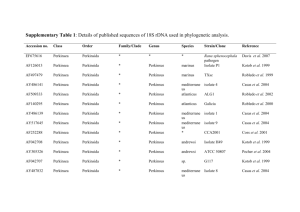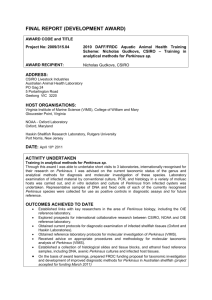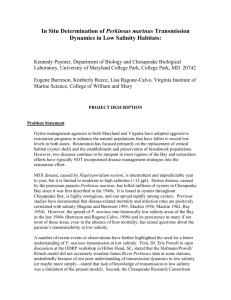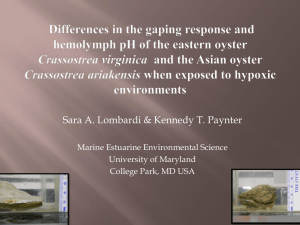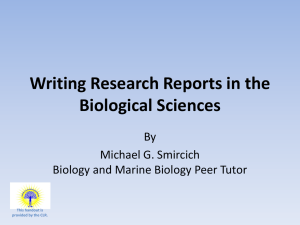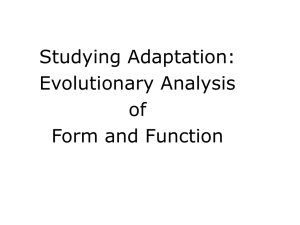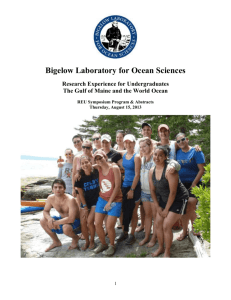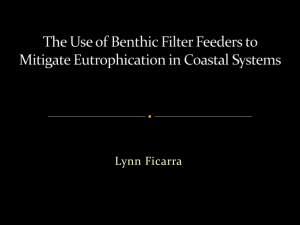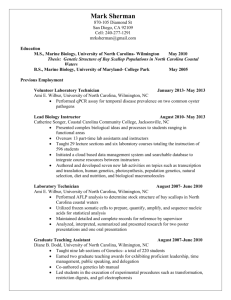3.1.5_PER - Virginia Institute of Marine Science
advertisement
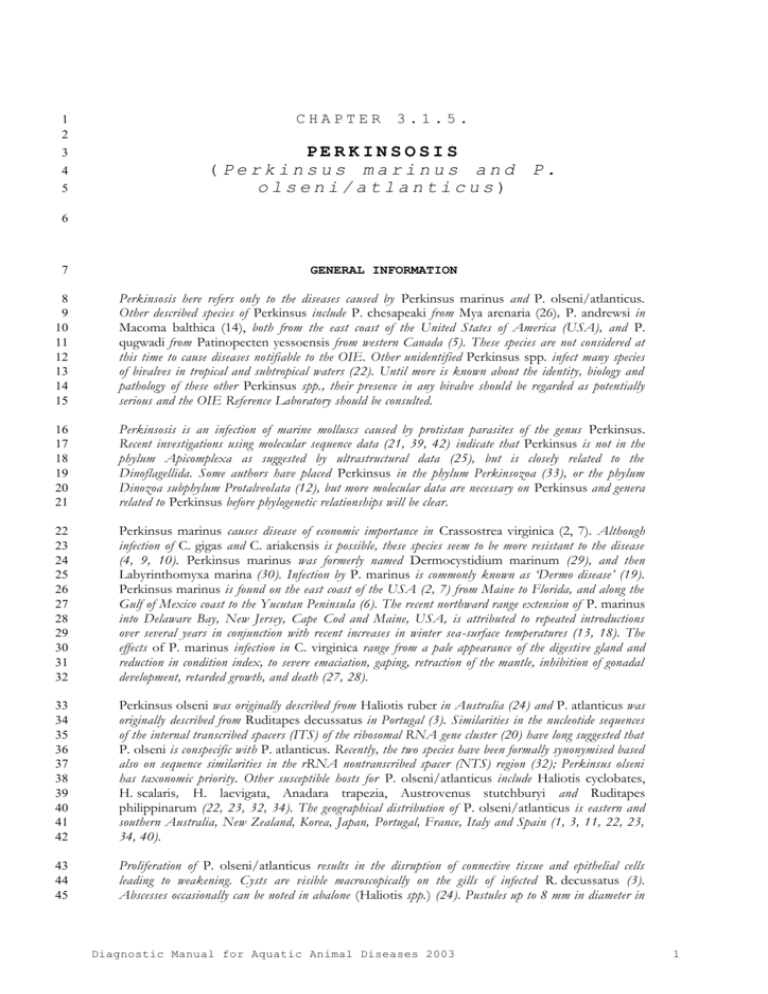
1 2 3 4 5 CHAPTER 3.1.5. PERKINSOSIS (Perkinsus marinus and P. olseni/atlanticus) 6 7 GENERAL INFORMATION 8 9 10 11 12 13 14 15 Perkinsosis here refers only to the diseases caused by Perkinsus marinus and P. olseni/atlanticus. Other described species of Perkinsus include P. chesapeaki from Mya arenaria (26), P. andrewsi in Macoma balthica (14), both from the east coast of the United States of America (USA), and P. qugwadi from Patinopecten yessoensis from western Canada (5). These species are not considered at this time to cause diseases notifiable to the OIE. Other unidentified Perkinsus spp. infect many species of bivalves in tropical and subtropical waters (22). Until more is known about the identity, biology and pathology of these other Perkinsus spp., their presence in any bivalve should be regarded as potentially serious and the OIE Reference Laboratory should be consulted. 16 17 18 19 20 21 Perkinsosis is an infection of marine molluscs caused by protistan parasites of the genus Perkinsus. Recent investigations using molecular sequence data (21, 39, 42) indicate that Perkinsus is not in the phylum Apicomplexa as suggested by ultrastructural data (25), but is closely related to the Dinoflagellida. Some authors have placed Perkinsus in the phylum Perkinsozoa (33), or the phylum Dinozoa subphylum Protalveolata (12), but more molecular data are necessary on Perkinsus and genera related to Perkinsus before phylogenetic relationships will be clear. 22 23 24 25 26 27 28 29 30 31 32 Perkinsus marinus causes disease of economic importance in Crassostrea virginica (2, 7). Although infection of C. gigas and C. ariakensis is possible, these species seem to be more resistant to the disease (4, 9, 10). Perkinsus marinus was formerly named Dermocystidium marinum (29), and then Labyrinthomyxa marina (30). Infection by P. marinus is commonly known as ‘Dermo disease’ (19). Perkinsus marinus is found on the east coast of the USA (2, 7) from Maine to Florida, and along the Gulf of Mexico coast to the Yucutan Peninsula (6). The recent northward range extension of P. marinus into Delaware Bay, New Jersey, Cape Cod and Maine, USA, is attributed to repeated introductions over several years in conjunction with recent increases in winter sea-surface temperatures (13, 18). The effects of P. marinus infection in C. virginica range from a pale appearance of the digestive gland and reduction in condition index, to severe emaciation, gaping, retraction of the mantle, inhibition of gonadal development, retarded growth, and death (27, 28). 33 34 35 36 37 38 39 40 41 42 Perkinsus olseni was originally described from Haliotis ruber in Australia (24) and P. atlanticus was originally described from Ruditapes decussatus in Portugal (3). Similarities in the nucleotide sequences of the internal transcribed spacers (ITS) of the ribosomal RNA gene cluster (20) have long suggested that P. olseni is conspecific with P. atlanticus. Recently, the two species have been formally synonymised based also on sequence similarities in the rRNA nontranscribed spacer (NTS) region (32); Perkinsus olseni has taxonomic priority. Other susceptible hosts for P. olseni/atlanticus include Haliotis cyclobates, H. scalaris, H. laevigata, Anadara trapezia, Austrovenus stutchburyi and Ruditapes philippinarum (22, 23, 32, 34). The geographical distribution of P. olseni/atlanticus is eastern and southern Australia, New Zealand, Korea, Japan, Portugal, France, Italy and Spain (1, 3, 11, 22, 23, 34, 40). 43 44 45 Proliferation of P. olseni/atlanticus results in the disruption of connective tissue and epithelial cells leading to weakening. Cysts are visible macroscopically on the gills of infected R. decussatus (3). Abscesses occasionally can be noted in abalone (Haliotis spp.) (24). Pustules up to 8 mm in diameter in Diagnostic Manual for Aquatic Animal Diseases 2003 1 Chapter 3.1.5. - Perkinsosis (Perkinsus marinus, P. olseni/atlanticus) 46 47 48 the foot and mantle of infected Haliotis spp. reduce market value. Perkinsus olseni/atlanticus was directly associated with high losses of the abalone H. laevigata in Australia (22) and mortality in the clam R. decussatus in Portugal (3) and in the clam R. philippinarum in Korea (34). 49 50 51 52 53 54 55 56 Morphology of life history stages is similar for all Perkinsus species. Trophozoites, characterised by a large vacuole and a displaced nucleus, occur intercellularly in connective and epithelial tissue. Mature trophozoites divide by successive binary fission resulting in the release of 8 –32 immature trophozoites (36, 44). The developmental cycle of P. marinus often occurs within phagocytes. Proliferation of all Perkinsus species is correlated with warm summer water temperatures (higher than 20°C) when pathogenicity and associated mortalities are highest. All life history stages appear to be infective (45). Under certain, poorly understood, conditions mature trophozoites enlarge and undergo zoosporulation. Although biflagellate zoospores are infective, the role of the zoospore in transmission in nature is unclear. 57 58 59 Reference methods for the detection of Perkinsus spp. are histological sections and culture in fluid thioglycollate medium (8, 17, 37, 38). For diagnosis, the recommended guidelines for sampling are those stated in Chapter I.2. of this Manual. 60 EXAMINATION PROCEDURES 61 1. SCREENING METHODS 1.1. Diagnosis by culture in Ray’s fluid thioglycollate medium 62 63 64 65 66 67 68 Tissue samples measuring approximately 5 10 mm are excised giving preference to rectal, gill and mantle tissue from oysters and clams, and adductor or foot muscles or mantle for abalone, and placed in fluid thioglycollate medium (Difco) containing antibiotics. Recommended antifungal/antibiotics are 200 units of mycostatin (Nystatin), 500 units penicillin G and 500 mg dihydro-streptomycin per ml of media (37). Chloromycetin can be used in place of penicillin/ streptomycin (38). Incubation is at 2225°C for between 4 and 7 days, in the dark. 69 70 71 72 73 Cultured parasites enlarge from 210 to 50–70 µm during incubation. After incubation, the fragments of tissue are collected and macerated with a scalpel blade on a glass slide, a drop of Lugol’s iodine 1/5 solution is added, and the preparation is covered with a cover-slip and allowed to sit for 10 minutes. The preparations are examined in the fresh state. Perkinsus hypnospores are spherical and the walls stain blue or bluish-black with Lugol’s iodine solution. 74 75 76 77 78 79 80 81 82 83 84 Infection intensity has been ranked (37) on a scale of 0 to 5 as follows: 0 = uninfected; 0.5 (very light) = fewer than ten parasites found in entire tissue preparation; 1 (light) = 11–100 cells present in entire preparation, parasites may be scattered or occur in isolated clusters of 10– 15 cells; 2 (light moderate) = some areas free of parasites, but other areas show localised concentrations of 24–50 cells, or cells uniformly distributed so that 2–3 cells occur in each field at 100 magnification; 3 (moderate) = parasites so numerous expect to find >3 cells in all fields at 100 magnification, masses of >50 cells are still more or less localised; tissue does not show blue/black colour macroscopically; 4 (moderate heavy) = parasite cells present in large numbers in all tissues, but less than half of tissue shows a blue/black colour macroscopically; 5 (heavy) = parasite cells occur in enormous numbers; major part of tissue appears blue/black macroscopically. 1.2. Histology 85 General histological procedures are detailed in Chapter I.2. of this Manual. Cut a transverse section through the visceral mass that includes gill, mantle and digestive gland and place the tissue sample in a fixative, such as Davidson’s fluid. The ratio must be no more than 1 volume of tissue to 10 volumes of fixative. 86 87 88 89 2 Diagnostic Manual for Aquatic Animal Diseases 2003 Chapter 3.1.5. - Perkinsosis (Perkinsus marinus, P. olseni/atlanticus) 90 91 92 Samples are processed by conventional histological procedures. Perkinsus spp. are revealed by many nonspecific stains, such as haematoxylin & eosin. Histology is not as sensitive a technique as fluid thioglycollate culture and misses many light infections (19). 93 94 95 96 97 98 Perkinsus marinus infection is usually systemic, although cells can be localised in the gut epithelium. For P. olseni/atlanticus, infection is usually located in connective tissues. Thus, the connective tissue of all organs may harbour immature trophozoites, mature trophozoites (‘signetring’ stages), and tomont division stages containing 2, 4, 8, 16 or 32 developing trophozoites (19, 36, 44). Mature trophozoites are characterised by the presence of a vacuole that displaces the nucleus towards the periphery of the cell. 99 100 101 102 Morphology of all life history stages is similar for all species. The size of trophozoites in infected hosts varies from 2–10 µm for P. marinus up to 16 µm for P. olseni/atlanticus. However, morphological characters are similar for all Perkinsus species and size is highly variable, so morphology alone cannot be used to distinguish species. 103 104 105 106 107 108 109 110 111 112 113 114 115 116 117 118 119 120 121 122 123 124 125 126 127 128 129 130 131 132 2. PRESUMPTIVE DIAGNOSTIC METHODS 2.1. Diagnosis by culture in thioglycollate medium and histology These methods, as described above (see Sections 1.1. and 1.2. of this Chapter), and used together, may be used as a presumptive diagnostic method for the genus Perkinsus. The techniques cannot be used to distinguish species. 2.2. Transmission electron microscopy Transmission electron microscopy procedures are given in detail in Chapter I.2 of this Manual. The ultrastructure of the zoospore has been thought to be diagnostic for the genus Perkinsus (3, 5, 36). However, recent evidence based on molecular data has shown that Colpodella, a predatory flagellate that has identical ultrastructure to Perkinsus zoospores, is not closely related to Perkinsus (43). Thus, ultrastructural morphology of zoospores does not appear to be a suitable diagnostic tool even for the genus Perkinsus. 2.3. Polymerase chain reaction A positive polymerase chain reaction (PCR) amplification is only a presumptive diagnosis because it detects DNA and not necessarily a viable pathogen. PCR primers have been developed for P. marinus (31, 41, 46) and P. atlanticus (15, 40), but they have not been thoroughly tested for inclusivity, specificity and sensitivity, especially in light of known sequence variability within a single Perkinsus species in the internal transcribed spacers (ITS) region (11, 16). A multiplex PCR (35) has been developed for P. marinus, Haplosporidium nelsoni (MSX) and Haplosporidium costale (SSO), but it has not been validated. Development of species specific and sensitive molecular diagnostic tools is an area of active research; however, PCR is not recommended at this time as a presumptive diagnostic method for any species of Perkinsus. 3. CONFIRMATORY IDENTIFICATION OF THE PATHOGEN 3.1. ITS region sequence analysis At the present time, the only way to confirm the identification of Perkinsus species is to compare ITS region nucleotide sequences with reference sequences deposited in the GenBank database (HTTP://WWW.NCBI.NLM.NIH.GOV/ENTREZ/). PCR primers have been designed that amplify the ITS region of any described Perkinsus spp. except P. qugwadi, from infected host tissue (11). The PCR products can then be sequenced for species identification. REFERENCES Diagnostic Manual for Aquatic Animal Diseases 2003 3 Chapter 3.1.5. - Perkinsosis (Perkinsus marinus, P. olseni/atlanticus) 133 134 135 1. ALMEIDA M., BERTHE F., THEBAULT A. & DINIS M.T. (1999). Whole clam culture as a quantitative diagnostic procedure of Perkinsus atlanticus (Apicomplexa, Perkinsea) in clams Ruditapes decussatus. Aquaculture, 177, 325–332. 136 137 2. ANDREWS J.D. (1996). History of Perkinsus marinus, a pathogen of oysters in Chesapeake Bay 1950– 1984. J. Shellfish Res., 15, 13–16. 138 139 3. AZEVEDO C. (1989). Fine structure of Perkinsus atlanticus n. sp. (Apicomplexa, Perkinsea) parasite of clams, Ruditapes decussatus, from Portugal. J. Parasitol., 75, 627–635. 140 141 142 4. BARBER B.J. & MANN R. (1994). Growth and mortality of eastern oysters, Crassostrea virginica (Gmelin, 1791), and Pacific oysters, Crassostrea gigas (Thunberg, 1793) under challenge from the parasite, Perkinsus marinus. J. Shellfish Res., 13, 109–114. 143 144 145 5. BLACKBURN J., BOWER, S.M. & MEYER G.R. (1998). Perkinsus qugwadi sp. nov. (incertae sedis), a pathogenic protozoan parasite of Japanese scallops, Patinopectin yessoensis, cultured in British Columbia, Canada. Can. J. Zool., 76, 627–635. 146 147 148 6. BURRESON E.M., ALVAREZ R.S., MARTINEZ V.V. & MACEDO L.A. (1994). Perkinsus marinus (Apicomplexa) as a potential source of oyster Crassostrea virginica mortality in coastal lagoons of Tabasco, Mexico. Dis. Aquat. Org., 20, 77–82. 149 150 7. BURRESON E.M. & RAGONE CALVO L.M. (1996). Epizootiology of Perkinsus marinus disease of oysters in Chesapeake Bay, with emphasis on data since 1985. J. Shellfish Res., 15, 17–34. 151 152 153 8. BUSHEK D., FORD S.E. & ALLEN S.K. (1994). Evaluation of methods using Ray's fluid thioglycollate medium for diagnosis of Perkinsus marinus infection in the eastern oyster, Crassostrea virginica. Ann. Rev. Fish Dis., 4, 201–217. 154 155 156 9. CALVO G.W., LUCKENBACH M.W., ALLEN S.K. & BURRESON E.M. (1999). A comparative field study of Crassostrea gigas (Thunberg 1793) and Crassostrea virginica (Gmelin 1791) in relation to salinity in Virginia. J. Shellfish Res., 18, 465–474. 157 158 159 10. CALVO G.W., LUCKENBACH M.W., ALLEN S.K. & BURRESON E.M. (2001). A comparative field study of Crassostrea ariakensis (Fujita 1913) and Crassostrea virginica (Gmelin 1791) in relation to salinity in Virginia. J. Shellfish Res., 20, 221–229. 160 161 162 11 163 12. CAVALIER-SMITH T. (1998). A revised six-kingdom system of life. Biol. Rev., 73, 203–266. 164 165 166 13. COOK T., FOLLI M., KLINCK J., FORD S. & MILLER J. (1998). The relationship between increasing sea-surface temperature and the northward spread of Perkinsus marinus (Dermo) disease epizootics in oysters. Estuarine Coastal Shelf Sci., 46, 587–597. 167 168 169 14. COSS C.A., ROBLEDO J.F., RUIZ G.M. & VASTA G.R. (2001). Description of Perkinsus andrewsi n. sp. isolated from the Baltic clam (Macoma balthica) by characterization of the ribosomal RNA locus, and development of a species-specific PCR-based diagnostic assay. J. Eukaryot. Microbiol., 48, 52–61. 170 171 172 15. DE LA HERRÁN R., GARRIDO-RAMOS M.A., NAVAS J.I., RUIZ REJÓN, C. & RUIZ REJÓN, M. (2000). Molecular characterization of the ribosomal RNA gene region of Perkinsus atlanticus: its use in phylogenetic analysis and as a target for a molecular diagnosis. Parasitology, 120, 345–353. 4 CASAS S.M., VILLALBA A. & REECE K.S. (2002). Study of the perkinsosis of the carpet shell clam Tapes decussatus in Galicia (NW Spain). I. Identification of the etiological agent and in vitro modulation of zoosporulation by temperature and salinity. Dis. Aquat. Org., 50, 51–65. Diagnostic Manual for Aquatic Animal Diseases 2003 Chapter 3.1.5. - Perkinsosis (Perkinsus marinus, P. olseni/atlanticus) 173 174 175 16. DUNGAN C.F., HAMILTON R.M.., HUDSON K.L., MCCOLLOUGH C.B. & REECE K.S. (2002). Two epizootic infectious diseases in Chesapaeke Bay commercial clams Mya arenaria and Tagelus plebius. Dis. Aquat. Org., 50, 67–78. 176 177 17. FISHER W.S. & OLIVER L.M. (1996). A whole-oyster procedure for diagnosis of Perkinsus marinus disease using Ray’s fluid thioglycollate culture medium. J. Shellfish Res., 15, 109–117. 178 179 18. FORD S.E. (1996). Range extension by the oyster parasite Perkinsus marinus into the northeastern United States: response to climate change? J. Shellfish Res., 15, 45–56. 180 181 182 19. FORD S.E. & TRIPP M.R. (1996). Diseases and defense mechanisms. In: The Eastern Oyster Crassostrea virginica, Kennedy V.S., Newell R.I.E. & Eble A.F., eds. Maryland Sea Grant College, College Park, Maryland, USA, 581–660. 183 184 185 20. GOGGIN C.L. (1994). Variation in the two internal transcribed spacers and 5.8S ribosomal RNA from five isolates of the marine parasite Perkinsus (Protista, Apicomplexa). Molec. Biochem. Parasitol., 65, 179–182. 186 187 21. GOGGIN C.L. & BARKER S.C. (1993). Phylogenetic position of the genus Perkinsus (Protista, Apicomplexa) based on small subunit ribosomal RNA. Molec. Biochem. Parasitol., 60, 65–70. 188 189 22 190 191 23. HAMAGUCHI M., SUZUKI N., USUKI H. & ISHIOKA H. (1998). Perkinsus protozoan infection in short-necked clam Tapes (=Ruditapes) philippinarum in Japan. Fish Pathol., 33, 473–480. 192 193 24. LESTER R.J.G. & DAVIS G.H.G. (1981). A new Perkinsus species (Apicomplexa, Perkinsea) from the abalone, Haliotis ruber. J. Invertebr. Pathol., 37, 181–187. 194 195 25. LEVINE N.D. (1978). Perkinsus gen. n. and other new taxa in the protozoan phylum Apicomplexa. J. Parastitol., 64, 549. 196 197 198 26. MCLAUGHLIN S.M., TALL B.D., SHAHEEN A., ELSAYED E.E. & FAISAL M. (2000). Zoosporulation of a new Perkinsus species isolated from the gills of the softshell clam Mya arenaria. Parasite, 7, 115– 122. 199 200 27. MACKIN J.G. (1951). Histopathology of infection of Crassostrea virginica Gmelin by Dermocystidium marinum Mackin, Owen and Collier. Bull. Marine Sci. Gulf Caribb., 1, 72–87. 201 202 28. MACKIN J.G. (1962). Oyster disease caused by Dermocystidium marinum and other microorganisms in Louisiana. Publ. Inst. Mar. Sci. Univ. Texas, 7, 132–299. 203 204 205 29. MACKIN J.G., OWEN H.M. & COLLIER A. (1950). Preliminary note on the occurrence of a new protistan parasite, Dermocystidium marinum n. sp., in Crassostrea virginica (Gmelin). Science, 111, 328– 329. 206 207 30. MACKIN J.G. & RAY S.M. (1966). The taxonomic relationship of Dermocystidiium marinum, Mackin, Owen and Collier. J. Invert. Pathol., 8, 544–545. 208 209 31. MARSH A.G., GAUTHIER J.D. & VASTA G.R. (1995). A semiquantitative PCR assay for assessing Perkinsus marinus infections in the eastern oyster, Crassostrea virginica. J. Parasitol., 81, 577–583. 210 211 212 32. MURRELL A., KLEEMAN S.N., BARKER S.C. & LESTER R.J.G. (2002). Synonymy of Perkinsus olseni Lester & Davis, 1981 and Perkinsus atlanticus Azevedo, 1989 and an update on the phylogenetic position of the genus Perkinsus. Bull. Euro. Assoc. Fish Pathol., 22, 258–265. GOGGIN C.L. & LESTER R.J.G. (1995). Perkinsus, a protistan parasite of abalone in Australia: a review. Aust. J. Mar. Freshwater Res., 46, 639–646. Diagnostic Manual for Aquatic Animal Diseases 2003 5 Chapter 3.1.5. - Perkinsosis (Perkinsus marinus, P. olseni/atlanticus) 213 214 215 33. NOREN F., MOESTRUP O. & REHNSTAM-HOLM A. (1999). Parvilucifera infectans Norén et Moestrup gen. et sp. nov. (Perkinsozoa phylum nov.): a parasitic flagellate capable of killing toxic microalgae. Europ. J. Protistol., 35, 233–254. 216 217 34. PARK K.-I. & CHOI K.-S. (2001). Spatial distribution of the protozoan parasite Perkinsus sp. found in Manila clams, Ruditapes philippinarum, in Korea. Aquaculture, 203, 9–22. 218 219 220 35. PENNA M.-S., KHAN M. & FRENCH R.A. (2001). Development of a multiplex PCR for the detection of Haplosporidium nelsoni, Haplosporidium costale and Perkinsus marinus in the eastern oyster (Crassostrea virginica, Gmelin, 1791). Molec. Cell. Probes, 15, 385–390. 221 222 36. PERKINS F.O. (1996). The structure of Perkinsus marinus (Mackin, Owen & Collier, 1950) Levine, 1978 with comments on taxonomy and phylogeny of Perkinsus spp. J. Shellfish Res., 15, 67–87. 223 224 37. RAY S.M. (1954). Biological studies of Dermocystidium marinum, a fungus parasite of oysters. Rice Institute Pamphlet, Houston, Texas, USA, 114 pp. 225 226 38. RAY S.M. (1966). A review of the culture method of detecting Dermocystidium marinum with suggested modifications and precautions. Proc. Natl. Shellfish. Assoc., 54, 55–69. 227 228 39. REECE K.S., SIDDALL M.E., BURRESON E.M. & GRAVES J.E. (1997). Phylogenetic analysis of Perkinsus based upon actin gene sequences. J. Parasitol., 83, 417–423. 229 230 231 40. ROBLEDO J.A.F., COSS C.A. & VASTA G.R. (2000). Characterization of the ribosomal RNA locus of Perkinsus atlanticus and development of a polymerase chain reaction-based diagnostic assay. J. Parastol., 86, 972–978. 232 233 234 41. ROBLEDO J.A.F., GAUTHIER J.D., COSS, C.A., WRIGHT A.C. & VASTA G.R. (1998). Speciesspecificity and sensitivity of a PCR-based assay for Perkinsus marinus in the eastern Oyster, Crassostrea virginica: a comparison with the fluid thioglycollate assay. J. Parasitol., 84, 1237–1244. 235 236 42. SIDDALL M.E., REECE K.S., GRAVES J.E. & BURRESON E.M. (1997). ‘Total evidence’ refutes the inclusion of Perkinsus species in the phylum Apicomplexa. Parasitology, 115, 165–176. 237 238 239 43. SIDDALL M.E., REECE K.S., NERAD T.A. & BURRESON E.M. (2001). Molecular determination of the phylogenetic position of a species in the genus Colpodella (Alveolata). Am. Mus. Novitates, 3314, 1– 10. 240 241 242 44. SUNILA I., HAMILTON R.M. & DUNGAN C.F. (2001). Ultrastructural characteristics of the in vitro cell cycle of the protozoan pathogen of oysters, Perkinsus marinus. J. Eukaryot. Microbiol., 48, 348– 361. 243 244 245 45. VOLETY A.K. & CHU F.-L.E. (1994). Comparison of infectivity and pathogenicity of meront (trophozoite) and prezoosporangiae stages of the oyster pathogen Perkinsus marinus in eastern oysters, Crassostrea virginica (Gmelin, 1791). J. Shellfish. Res., 13, 521–527. 246 247 46. YARNALL H.A, REECE K.S., STOKES N.A. & BURRESON E. M. (2000). A quantitative competitive polymerase chain reaction assay for the oyster pathogen Perkinsus marinus. J. Parasitol., 86, 827–837. 248 249 * * * 6 Diagnostic Manual for Aquatic Animal Diseases 2003
